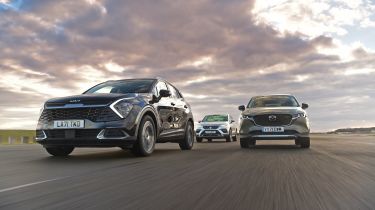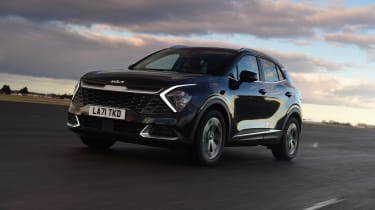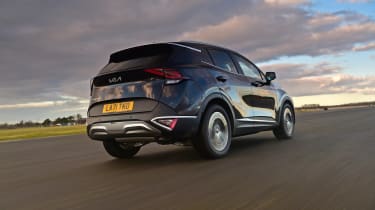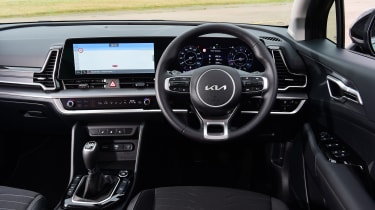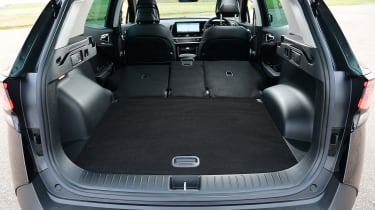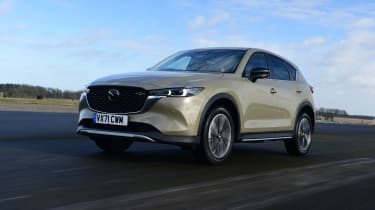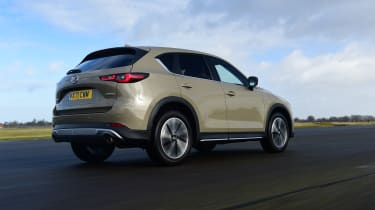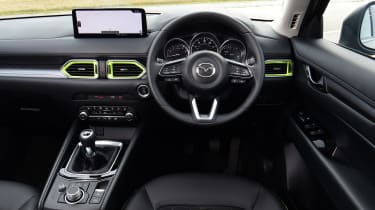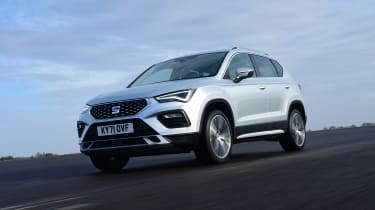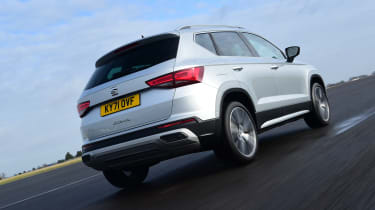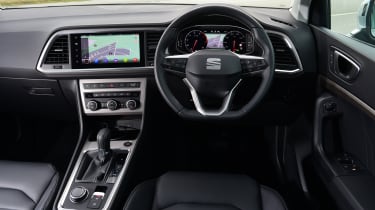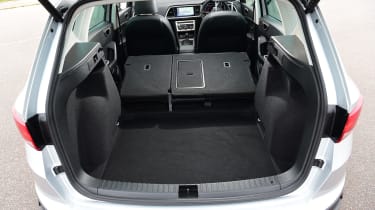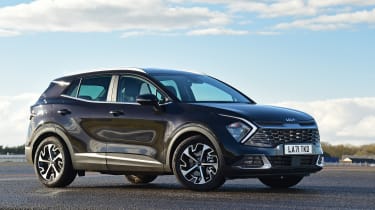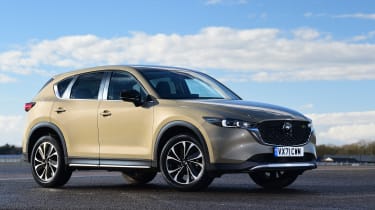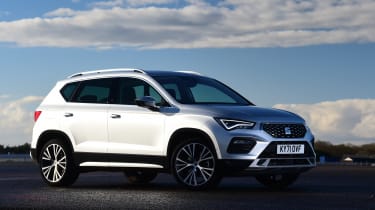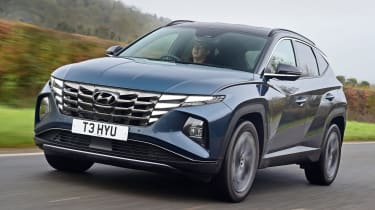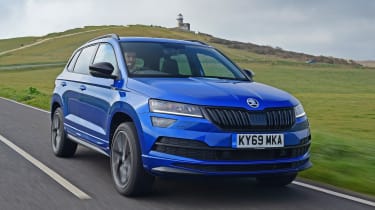Kia Sportage vs Mazda CX-5 vs SEAT Ateca: 2022 group test review
The new Kia Sportage takes on Mazda and SEAT rivals to find out which one makes the best family-friendly five-seat SUV
One of the cars that established Kia as a serious contender in the new-car market was the third-generation Sportage. With head-turning looks, a practical interior and plenty of kit, it set a template for nearly every Kia model that followed.
The fourth generation consolidated the Sportage’s position to become one of the UK’s best-selling five-seat family SUVs, and now the fifth version is here with a new level of tech and radical looks.
However, the compact SUV sector is a busy one, so as well as frequent new model launches, the mid-life updates come thick and fast, too. The Mazda CX-5 has been given a freshen up for 2022, with a revised look front and rear and a new trim structure.
Another model that has been under the knife is the SEAT Ateca. The Spanish firm’s first SUV has been around for a while now, and it was the subject of a facelift in 2020; now for 2022 the top-spec Xperience Lux comes with more safety kit as standard.
Do the updates help our two challengers to come out on top in this test, or does the new Sportage move the compact SUV class on once again?
Kia Sportage
|
Model: |
Sportage 1.6 T-GDi 3 |
|
Price: |
£30,945 |
|
Engine: |
1.6-litre 4 cyl turbo, 148bhp |
|
0-62mph: |
11.7 seconds |
|
Test economy: |
40.5mpg/8.9mpl |
|
CO2: |
154g/km |
|
Annual road tax: |
£155 |
The fifth-generation Sportage tested here comes in mid-spec 3 trim, powered by the 1.6 T-GDi petrol engine. It costs £30,945, with the only option being premium paint, which adds £650 to the price.
Used - available now

2022 Volkswagen
ID.3
16,600 milesAutomaticElectric
Cash £15,200
2021 SEAT
Arona
13,926 milesManualPetrol1.0L
Cash £13,800
2018 BMW
3 Series
27,300 milesAutomaticPetrol3.0L
Cash £23,487
2023 Peugeot
2008
48,844 milesManualPetrol1.2L
Cash £14,500Design & engineering
First things first: the front end of the Sportage is probably its most divisive feature. The firm’s ‘tiger nose’ design motif has been stretched to its limit, and the broad grille, wide-set LED headlights and arrow-shaped daytime running lights have a hint of Citroen about them. The fussy details are a long way from the clean look of the Sportage Mk3.
Further back, the new car is considerably more conventional. The overall shape is standard SUV with familiar styling cues, such as roof rails and black wheelarch extensions. At the back, the curvy rear end features slender tail-lights, while the number plate is set into the bumper, just like on the previous generation.
Under the skin, the Sportage uses the same platform as the Hyundai Tucson, so it features MacPherson strut suspension up front and a multi-link axle at the rear, which allows four-wheel drive to be fitted to higher-spec versions. Power comes from a range of 1.6-litre turbo petrol and diesel engines with varying degrees of fuel-saving tech, including 48-volt, mild-hybrid and plug-in hybrid assistance. Go for the 1.6 T-GDi with a six-speed manual gearbox as tested here and you just get stop-start, but it’s an effective set-up that’s quick to activate.
It’s the Sportage’s interior that is the real highlight. Choose a mid-spec 3 model or higher and you’ll get a large dual-screen set-up that curves around the dashboard, similar to the one seen in the electric EV6, while the air vents and interior door handles carry a T-shaped design. There’s a neat digital panel lower down on the dashboard that can be set up to show either climate or multimedia functions, too. All versions of the Sportage get front and rear parking sensors, smartphone connectivity, three-zone climate control, and auto lights and wipers.
Driving
The main takeaway from the new Sportage is that it’s very comfortable and refined. Fire up the petrol engine and it’s barely audible at idle, and while there’s a muted hum when accelerating that turns thrashy if you use all the revs, it’s never intrusive. Long gearing means acceleration is measured rather than brisk, but decent torque means you don’t need to work the engine hard to make progress.
Wind and road noise are also well isolated from the cabin, with only the roughest surfaces having an impact, and even then, you’ll find yourself able to have a conversation with back-seat passengers without needing to raise your voice.
This refinement is backed up by a soft suspension set-up that focuses on comfort over sporty handling. Bumps are smoothed out effectively – they’re heard more than they are felt – and there’s a floaty sensation as the car tackles uneven surfaces.
The downside of this soft character is that the Kia Sportage is by no means sporty to drive. There’s plenty of lean in corners, while the car bobs up and down when tackling mid-corner bumps. Both rivals here offer a more focused, ‘tied-down’ character, if that’s what you want from your family SUV.
There’s a lightness to the Kia’s controls that further reinforces its lack of sporting pretensions. The steering is quick and easy to turn, but delivers no feedback, while all of the other controls have a lightness that means driving the Sportage is a breeze. It does a job without offering any fun.
Practicality
The latest Kia Sportage is bigger than its predecessor in every direction, but it’s still not quite as large as the CX-5 here. However, the Kia does have the roomiest cabin. There’s lots of space up front, while fitting an electric parking brake and placing the lever to the right of the steering wheel creates lots of space for storage.
But it’s in the rear where a lot of attention has been given. While the cabin is a little dark, there are lots of useful touches. The headrests feature large hooks for hanging items such as bags or coats, there are USB-C sockets in the sides of the seats, and all versions feature three-zone climate control, so back-seat passengers have their own temperature setting. On 3 trim the outer rear seats are heated, too, while the seat backs recline in six steps.
Boot space is also generous, with 591 litres on offer, a huge 81 litres more than in the SEAT, and 1,780 litres with the seats folded. There’s a 40:20:40 split to the backs, while a deep tray beneath the boot floor is useful to help keep valuables out of sight.
Ownership
When Kia introduced its seven-year/100,000-mile warranty with the first Cee’d hatch, it was designed to help draw buyers in from established brands. Today, Kia’s cars have more than enough going for them, so the long warranty is simply a bonus. In contrast, Mazda and SEAT offer three years/60,000 miles of cover.
Look at the small print, and the CX-5 and Ateca have unlimited mileage cover for the first two years, while on the Sportage it’s three years. Overall mileage limits mean you can average 20,000 miles a year in the Mazda or SEAT before the warranty lapses, but only 14,286 miles a year in the Kia.
Running costs
Servicing the Sportage is made easier with a service plan, and Kia offers packages that can cover the car from two to five years. You can pay for this up front or by instalment, or even include it in any monthly finance repayments. Costs are reasonable, too, with two services coming in at £389, compared with £462 for the SEAT. Both cars have 10,000-mile/12-month intervals, while the CX-5 has a 12,500-mile schedule.
Testers’ notes
“The Sportage’s tailgate cuts low into the rear bumper, so there’s just hard-wearing black plastic to load heavy items over, and no paint to scratch.”
Mazda CX-5
|
Model: |
Mazda CX-5 Skyactiv-G Sport Ed |
|
Price: |
£30,765 |
|
Engine: |
2.0-litre 4cyl, 163bhp |
|
0-62mph: |
10.5 seconds |
|
Test economy: |
40.2mpg/8.8mpl |
|
CO2: |
153g/km |
|
Annual road tax: |
£155 |
The CX-5 has been given a nip, a tuck and a range overhaul for 2022. We’re testing the Sport Edition here, which costs £30,765, undercutting the Sportage 3 by £180. The car in our pictures is in Newground trim, a new spec introduced with the range update that slots in below the Sport Edition, priced at £29,145.
Design & engineering
If you’re after a handsome-looking compact SUV, then the Mazda CX-5 easily fits the bill. It’s neatly proportioned, while the narrow headlights and smart grille are in stark contrast to the Kia’s fussy front end.
Inside, the cabin features a lot of black plastic (although the Newground model in our pictures adds lime-green highlights to brighten things up), and the layout is wholly conventional and easy to get along with. Mazda’s Multimedia Commander set-up gives you an option other than the touchscreen to use when on the move, although the analogue dials don’t have the modern glitz of the digital set-ups in both rivals here. It all feels well built, though.
Despite the majority of its rivals now offering small-capacity turbocharged petrol engines to meet performance and emissions legislation, Mazda goes its own way with large-capacity naturally aspirated power instead. But while the Mazda 3 hatch makes use of the firm’s innovative Skyactiv-X drivetrain, the CX-5 just has regular petrol and diesel options.
The 2.0-litre Skyactiv-G petrol unit outguns both rivals here with 163bhp, but has a lower torque figure, at 213Nm, while it makes its power at higher revs than either rival, too. Drive is sent to the front wheels via a six-speed manual gearbox, and like the Sportage, an automatic gearbox is available, but there isn’t any form of mild-hybrid assistance here.
The Sport Edition model offers a generous level of kit. It largely matches the Sportage 3 in most areas, but also adds leather upholstery and keyless entry and starting, plus there’s a powered tailgate.
Driving
Mazda takes great pride in producing cars that deliver entertaining handling, and the Mazda CX-5 is a case in point. It’s one of the best-handling cars in the compact SUV class, with an agility and nimbleness that the Kia Sportage can’t match. In fact, it’s a close-run thing between the Mazda and SEAT for which can deliver the most driving fun, with both cars feeling agile and responsive to inputs.
The CX-5 has light but direct steering, while the firm suspension set-up limits body roll in corners. However, the Mazda feels like it hasn’t quite got as much grip as the SEAT when you’re pushing the limits, especially when it’s slippery. It’s fine most of the time, but if you’re pressing on, then the car feels like it has a tendency to wash over surfaces, rather than dig in for grip.
The other aspect of the CX-5 that dominates the driving experience is the petrol engine. While a 0-62mph time of 10.5 seconds is 1.2 seconds faster than the Kia’s, a lack of torque means you have to work the Mazda’s engine hard to deliver results.
There’s 213Nm on offer, which is 37Nm down on both rivals, and this maximum only comes on stream between 4,000-6,000rpm, compared with 1,500rpm in the Kia and SEAT. Thankfully the six-speed gearbox has a superb action, but there are times where you need to shift down a gear to keep making progress where it wouldn’t be necessary in either rival.
Practicality
The CX-5 has to give second best to the Sportage for versatility, because it has less boot space and fewer practical touches. However, one neat addition is that the load cover can clip to the powered tailgate, so it lifts up and out of the way each time the boot is opened.
A boot capacity of 522 litres is nearly 70 litres down on the Kia’s, though, and while the back seats have a 40:20:40 split, they can only be folded via levers in the boot.
There’s just one seat back setting for passengers, but space is still decent for leg and headroom, and the seats are comfortable. You don’t get as many mod cons in the back, with just a pair of air vents but no temperature controls or USB sockets.
Space up front is decent, though, and the driving position can be set low for a sportier feel. Visibility is also good, and as with its rivals here, front and rear parking sensors and a reversing camera are fitted as standard to help with low-speed manoeuvres.
Ownership
According to the Driver Power new-car ownership survey, Mazda owners think their cars deliver the goods, but the dealership experience is a little lacking. The Japanese firm ranked fourth in our 2021 manufacturer survey, but its dealerships placed 19th out of 21 in that poll.
In comparison, Kia scored outstanding second and third-place finishes in those respective surveys, while SEAT ranked 15th as a manufacturer, and its dealers placed fifth.
Running costs
These days, company car buyers will be paying through the nose for Benefit-in-Kind tax if they choose a conventional petrol or diesel-powered car. Official emissions are pretty much level-pegging between these three, but it means that they all sit in a relatively high 34 per cent tax bracket.
Because the CX-5 has the lowest list price, it also has the lowest BiK rate, with 20 per cent taxpayers facing an annual bill of £2,051. That’s only £11 a year less than the Kia Sportage, though.
If you want to reduce your tax costs, then the only option with the CX-5 (or the Ateca, for that matter) is to go diesel, because there are no hybrid alternatives. It’s a different story with the Sportage, since Kia is offering hybrid and plug-in hybrid versions from the outset, which will help to reduce your outgoings.
Testers’ notes
“The CX-5 has two larger options in other markets. There’s the CX-8 for the Far East, while the CX-9 is sold in the Americas. Both are seven-seaters.”
SEAT Ateca
|
Model: |
SEAT Ateca 1.5 TSI Evo 150PS Xperience Lux |
|
Price: |
£32,190 |
|
Engine: |
1.5-litre 4 cyl turbo, 148bhp |
|
0-62mph: |
9.3 seconds |
|
Test economy: |
32.6mpg/7.2mpl |
|
CO2: |
153g/km |
|
Annual road tax: |
£155 |
An update in mid-2020 gave the SEAT Ateca a new lease of life, with a subtly revised front end and new tech on board. Here we’re testing it in top-spec Xperience Lux trim, which costs £32,190, although the car in our pictures is the DSG auto-equipped version, which costs £33,570.
Design & engineering
When the Ateca was launched in 2016, not only was it SEAT’s first SUV, but it was also one of the first models within the Volkswagen Group to use the A1 version of its MQB modular platform system. The Ateca’s underpinnings are shared with the Skoda Karoq (both cars are built on the same production line in the Czech Republic) and the VW T-Roc, too.
In terms of size, the Ateca is more compact than either rival here. It’s shorter, lower and narrower, so there’s not as much room to package everything. A smaller 50-litre fuel tank is fitted for starters, while the small dimensions mean fitting hybrid drive isn’t really an option.
The majority of Atecas are front-wheel drive, although the more powerful 2.0-litre petrol and diesel engines are offered with four-wheel drive. There are 1.0 and 1.5 TSI petrol engines available as well, but the smaller engine is only offered in lower specs. The 148bhp 1.5 TSI tested here can be had with either a six-speed manual gearbox or a seven-speed twin-clutch auto, while cylinder deactivation helps to boost fuel efficiency.
The most recent facelift left the Ateca’s overall shape alone, but added a new grille and bumper, while the interior was updated with newer in-car entertainment systems and a revised operating system, while standard kit was upgraded across the range. On top of that, an update for 2022 saw the introduction of SEAT’s Pre-Crash Assist system to Xperience Lux models to boost its safety credentials even further.
Given that it’s at the top of the range, the Xperience Lux model also comes with plenty of standard kit, including heated leather seats, 19-inch alloy wheels, a 360-degree camera system, digital dials and a power-operated tailgate.
Driving
While SEAT has hived off its sportiest models into the separate Cupra brand, there’s still fun to be had within the regular line-up. Our car’s 148bhp 1.5 TSI engine is one that’s found across the VW Group, and here it delivers good performance. A 0-62mph time of 9.3 seconds is 1.2 seconds faster than the second-placed Mazda’s, and the engine’s punchy power delivery means the Ateca feels more eager than its rivals whenever you sprint off the line.
The six-speed gearbox has a positive shift that’s a match for the Mazda’s for accuracy, while the steering weights up naturally the faster you go. SEAT’s Drive profile has four settings (Eco, Normal, Sport and Individual) that allow you to set the steering weight and throttle response. In addition, the system also tweaks the efficiency of the climate control and the shifts of the DSG gearbox on auto models.
There’s plenty of grip, helped by the standard-fit 19-inch wheels on Xperience Lux models, while a firm suspension set-up means there’s minimal body roll when pressing on. The pay-off for this sporty drive is that the ride is on the firm side. However, it’s hardly uncomfortable, and is in keeping with the Ateca’s sportier character.
Practicality
Smaller dimensions mean the Ateca can’t match its rivals here for practicality. That’s not to say that it’s cramped; it’s just that there’s more space on offer in the Kia and Mazda.
Up front there’s plenty of wheel and seat adjustment, while the upright dashboard puts everything close to hand. The old car’s physical climate controls remain unchanged, too, so there are no issues with using them while on the move.
If you’re travelling four up, then there shouldn’t be too many issues with space, although legroom in the back could be better. Add a third passenger and space is a little narrow in the middle seat, and as in the Mazda, there are air vents in the back, but no temperature controls.
Boot space measures at 510 litres with the seats in place, but there’s a significant step in the floor when they’re folded, which compromises the 1,604-litre space somewhat, and there is just 60:40 folding, too.
Ownership
There’s a five-star Euro NCAP rating for the Ateca, and the CX-5 also has a five-star score. However, these cars were examined in 2016 and 2017 respectively, while the test is tougher today. The Sportage has yet to be tested by Euro NCAP, although given that it uses the same running gear and safety kit as the five-star- rated Hyundai Tucson, it should be a safe machine.
In practical terms, the major differences between the three boil down to their lane assist technology. While SEAT’s and Mazda’s offer audible and visual alerts, the Kia’s system actively steers for you. There are two levels of assistance, too, with the higher setting tracking the car in its lane, rather than steering you back into line if you stray. It’s not as intrusive as some systems, and it can be easily turned off with the long press of a steering wheel button. Just be aware that the system defaults to on every time you turn on the ignition.
Running costs
The Kia and Mazda both returned fuel economy on test similar to their official WLTP figures, so they can travel almost 500 miles on a full tank.
Our figures for the Ateca are for the DSG-equipped model, which has poorer official figures than the manual model by around 3mpg. Either way, a smaller fuel tank means that neither version of the Ateca will be able to travel as far between fills as its rivals here.
Testers’ notes
“The TSI engine shuts down two of its four cylinders on light throttle loads. It works so smoothly that the only sign it’s working is an icon in the trip display.”
Verdict
First place: Kia Sportage
The Kia Sportage takes the family-friendly formula set out by the previous generations and builds on it by offering even more space, adding some neat practical touches and a dazzling infotainment system that makes its rivals here look a generation behind. The looks might be divisive, and it’s not the most fun car to drive, but it’s hugely refined at all speeds, and it fits the brief perfectly as versatile family transport.
Second Place: Mazda CX-5
If you’re looking for driving fun from a family SUV, then few rivals can match the Mazda CX-5. It’s a sharp-looking machine, too, and while the interior isn’t quite as large as the Sportage’s, there’s still a useful amount of space. Factor in the long kit list, and there’s lots to like. We just wish that the engine had a bit more low-down grunt. If it weren’t for that, the Sportage would’ve had a far tougher time here.
Third Place: SEAT Ateca
The Ateca is a close match for the CX-5 for driver involvement, its punchy petrol engine delivers great performance, and Xperience Lux trim delivers all the kit that you could possibly want. However, the SEAT’s compact dimensions mean it’s not as practical as its rivals here, the touchscreen infotainment system is a letdown, and higher monthly repayments count against it, too.
Also consider…
Hyundai Tucson
- Model: Hyundai Tucson 1.6 T-GDi Premium
- Price: £30,810
- Engine: 1.6-litre 4 cyl,148bhp
If the Sportage’s looks are too challenging for you, then there’s an alternative in the shape of the Tucson. It comes with the same powertrain, and Premium trim largely matches the Sportage 3 in terms of standard kit.
Skoda Karoq
- Model: Skoda Karoq 1.5 TSI Sportline
- Price: £31,835
- Engine: 1.5-litre 4cyl, 148bhp
A close relative of the SEAT Ateca, the Karoq has also been the subject of a facelift. Sportline versions offer racier looks, but the practical touches remain, although the Varioflex sliding back seats found in other versions aren’t available here.
Figures
|
Kia Sportage 1.6 T-GDi 3 |
Mazda CX-5 Skyactiv-G Sport Edition |
SEAT Ateca 1.5 TSI Evo 150PS Xperience Lux | |
|
On the road price/total as tested |
£30,945/£31,595 |
£30,765/£30,765 |
£32,190/£32,190 |
|
Residual value (after 3yrs/36,000) |
£16,339/52.8% |
£18,674/60.7% |
£16,095/50.0% |
|
Depreciation |
£14,606 |
£12,091 |
£16,095 |
|
Annual tax liability std/higher rate |
£2,063/£4,126 |
£2,051/£4,101 |
£2,147/£4,295 |
|
Annual fuel cost (12k/20k miles) |
£2,011/£3,352 |
£2,026/£3,377 |
£2,498/£4,164 |
|
Insurance group/quote/VED |
19/£434/£155 |
18/£396/£155 |
18/£389/£155 |
|
Cost of 1st/2nd/3rd service |
£389 (2 services) |
N/A |
£462 (2 services) |
|
Length/wheelbase |
4,515/2,680mm |
4,575/2,700mm |
4,381/2,638mm |
|
Height/width |
1,650/1,865mm |
1,680/1,845mm |
1,615/1,841mm |
|
Engine |
4cyl in-line/1,598cc |
4cyl in-line/1,998cc |
4cyl in-line/1,498cc |
|
Peak power/revs |
148/5,500 bhp/rpm |
163/6,000 bhp/rpm |
148/5,000 bhp/rpm |
|
Peak torque/revs |
250/1,500 Nm/rpm |
213/4,000 Nm/rpm |
250/1,500 Nm/rpm |
|
Transmission |
6-spd man/fwd |
6-spd man/fwd |
6-spd man/fwd |
|
Fuel tank capacity/spare wheel |
54 litres/repair kit |
56 litres/repair kit |
50 litres/£120 |
|
Boot capacity (seats up/down) |
591/1,780 litres |
522/1,638 litres |
510/1,604 litres |
|
Kerbweight/payload/towing weight |
1,526/559/1,650kg |
1,560/460/1,800kg |
1,408/522/1,800kg |
|
Turning circle |
10.9 metres |
11.9 metres |
10.8 metres |
|
Basic warranty (miles)/recovery |
7yrs (100k)/1yr |
3yrs (60k)/3yrs |
3yrs (60k)/2yrs |
|
Driver Power manufacturer/dealer pos |
2nd/3rd |
4th/19th |
15th/5th |
|
NCAP: Adult/child/ped./assist/stars |
N/A |
95/80/78/59/5 (’17) |
93/84/71/60/5 (’16) |
|
0-62mph/top speed |
11.7 secs/108mph |
10.5 secs/125mph |
9.3 secs/125mph |
|
Auto Express economy/range |
40.5/8.9/481 miles |
40.2/8.8/495 miles |
32.6/7.2/359 miles |
|
WLTP combined |
41.5mpg |
41.5mpg |
42.2mpg |
|
WLTP combined |
9.1mpl |
9.1mpl |
9.3mpl |
|
Actual/claimed CO2/tax bracket |
161/154g/km/34% |
188/153g/km/34% |
232/153g/km/34% |
|
Airbags/Isofix/park sensors/camera |
Six/two/f&r/yes |
Six/two/f&r/yes |
Six/two/f&r/yes |
|
Auto box/lane keep/blindspot/AEB |
£1,700/yes/no/yes |
£1,600/yes/yes/yes |
£1,380/yes/yes/yes |
|
Climate control/cruise control |
Yes/yes |
Yes/yes |
Yes/adaptive |
|
Leather/heated seats |
No/four |
Yes/two |
Yes/two |
|
Metallic paint/LED headlights |
£650/yes |
£580/yes |
Yes/yes |
|
Keyless entry & go/power tailgate |
No/no |
Yes/yes |
Yes/yes |
|
Sat-nav/digital dashboard |
Yes/yes |
Yes/no |
Yes/yes |
|
DAB radio/connected services |
Yes/yes |
Yes/yes |
Yes/yes |
|
Wireless charge/CarPlay/Android Auto |
No/yes/yes |
Yes/yes/yes |
Yes/yes/yes |
